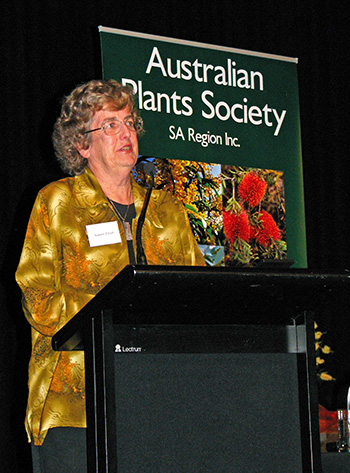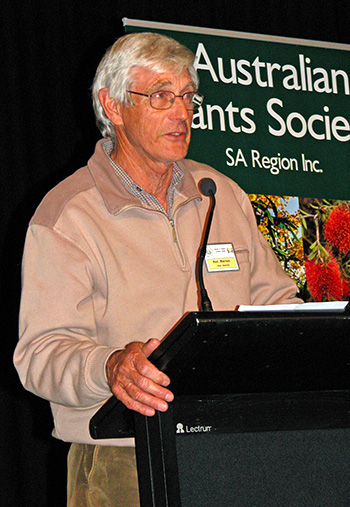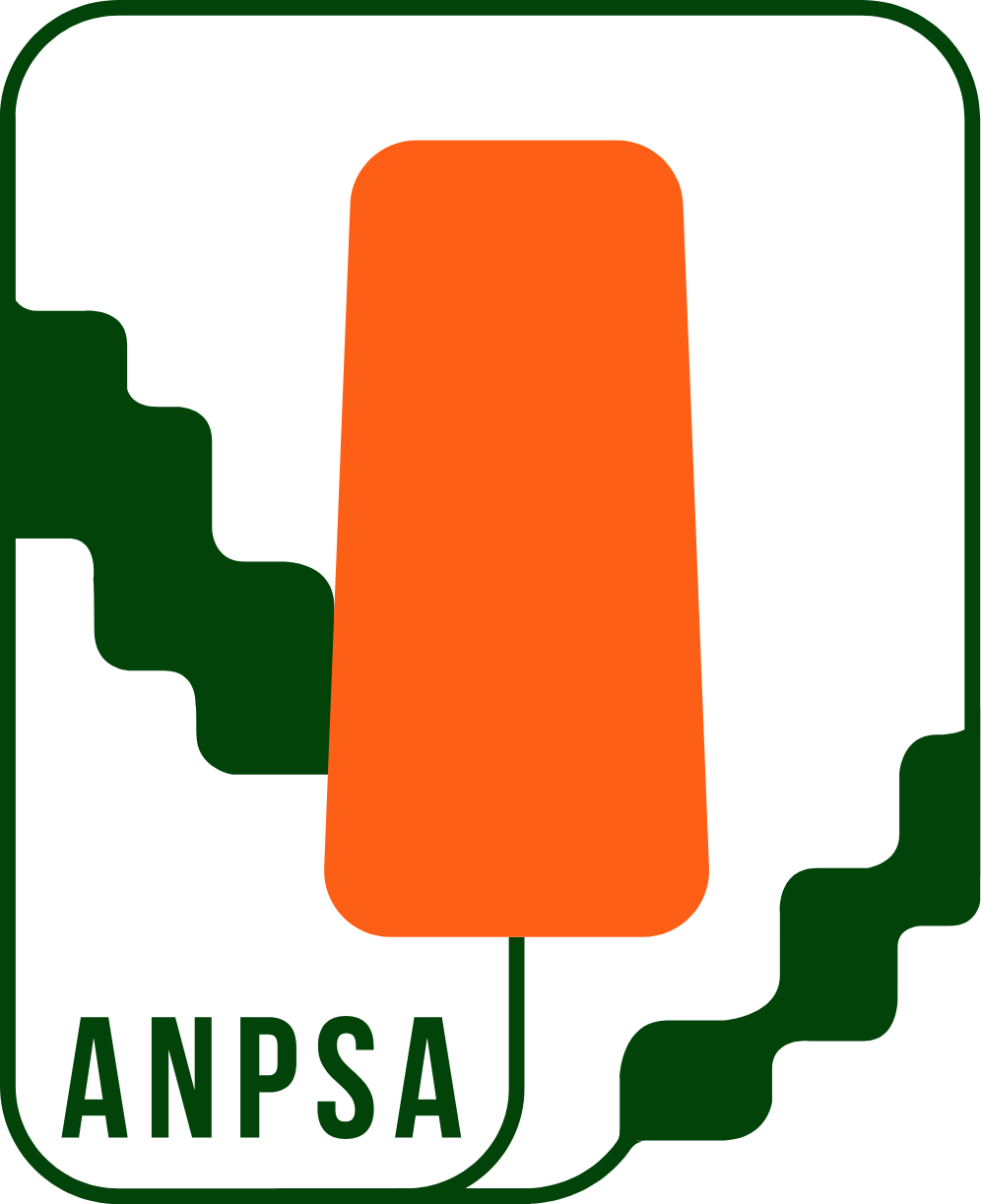Australian Plants Awards 2011
At the 2011 ANPSA Conference in South Australia, Australian Plants Awards for 2011 were conferred upon Gwen Elliott (Professional award) and Ken Warnes (Amateur award). Citations read by the Chairman of the Awards Committee, Paul Kennedy are printed below.
Gwen Elliot AM
 |
| Photo: Cathy Powers |
Gwen has been an active native plant enthusiast, propagator, grower, educator and promoter for over forty years. She is a member of the Australian Plants Society Victoria, the Maroondah Group and Friends of Karwarra. She has a keen interest in the Royal Botanic Gardens, Cranbourne, where she is an active member and past President of the Friends Group which has raised funds for the gardens. Gwen is a founding member of the Horticultural Media Association (Vic) and has been both honorary secretary and president of this group. For more than ten years, she has been leader of ANPSA Epacris Study Group and is currently a member of the Victorian Executive of the Australian Open Gardens Scheme.
She and her husband owned and operated both wholesale and retail nurseries specializing in native plants from 1963 to 1992. Gwen is now involved as a propagator for outback plants.
Gwen has made numerous guest appearances on radio and television gardening programs over many years and since 1997 has been a regular presenter on 3CR on Sunday mornings. She has been a guest speaker to numerous groups and at the 1995 and 2009 ASGAP seminars. She has lectured at symposia and to students of horticulture, both in Australia and overseas. With her husband, Rodger, she has led many tours aimed at furthering the knowledge and growing of Australian native plants.
Since 1998 she has been a writer for a regular monthly column in “Horticulture Australia”. “Australian Plants” journals have contained articles by Gwen over many years, but her role as one of the “unofficial editors” and typist spanning over 30 years in the publication of the nine volumes of “Encyclopaedia of Australian Plants Suitable for Cultivation” was duly noted by the authors at the launch of the final book. As author, Gwen has written ten books on Australian plants which have all proved to be popular because of her style of writing which enables easy understanding of the subject.
In 1987 Gwen was awarded Honorary Life Membership of APS Vic. She is also Honorary Life Member of the Arboretum Associates which is a friends group formed in 1976 to promote the University of California arboretum, which has a large collection of Australian plants. In 2001 Gwen was awarded Membership of the Order of Australia (AM) for service to horticulture of native plants, particularly through the Society for Growing Australian Plants. In 2004 Gwen was the recipient of the F. Owen Pearce Award of Horticulture from the Strybing Arboretum Society for her role in expanding the horticultural potential and recognition of Australian flora for Californian gardens.
The contribution Gwen has made to the furtherance of Australian native plants is immeasurable. She has been a dedicated member of the Australian Plants Society at national, state and district levels. Her leadership roles are well documented and her involvement at so many levels has ensured continued prominence in the understanding of our unique Australian flora.
Ken Warnes
 |
| Photo: Cathy Powers |
Ken has been a keen observer of plants since childhood and began studying eremophilas in particular in the early 1960s. He has been an active and enthusiastic scholar and mentor in connection with the genus ever since and has been unstinting in his research and assistance to others throughout the past 50 years.
Ken joined the South Australian Region of the Society for Growing Australian Plants in 1963 and has been a member ever since. He also has an interest in eucalypts and was a member of the Coolabah Club, an association of country based tree growers where he gave valuable assistance with propagation and growing. He began his life’s interest in eremophilas by becoming a founding member of “Project Eremophila” which was a South Australian SGAP project. Eventually this was superseded by the Eremophila Study Group in 1975 and he was leader of the Study Group for five years.
He is a member of the Arid Lands Botanic Garden where he has advised and assisted in layout, planting and introduction of new species. From 1978 to 1987 Ken was a member of the Lower North Group where he served on the committee and as president.
Following this, Ken joined the Para Districts Group where he has been an active member.
Ken’s introduction to eremophilas began in 1963 on a trip east of the northern Flinders Ranges. In 1967 he was in the Gawler Ranges, where he observed and collected eremophilas and has been back many times since. In 1968, with Bruce Copley, he collected the type specimens of Grevillea parallelinervis and on subsequent trips to the far west and north west of South Australia, brought back specimens for Dr Bryan Barlow from Flinders University and Dr Bob Chinnock of the South Australian Herbarium. During this time he kept careful records and has propagated and grown many eremophilas on his property. At present he is attempting to keep a record of a number of hybrids that are being collected in the field and evolving in members’ gardens.
Ken has contributed articles to “Australian Plants”, the South Australian journal, “Native Plants for NSW” and the Eremophila Study Group newsletter. He reviewed the Eremophila section in the Encyclopaedia of Australian Plants for Rodger Elliot and David Jones. He also assisted Dr Bob Chinnock with his book on Eremophila and Allied Genera and a Monograph of the Myoporaceae, published in 2007. In 2008 he assisted the authors, Maree Goods, Norma Boschen and Russell Wait with “Australian Eremophilas, changing gardens for a changing climate” and wrote the section on the “History of Cultivation”.
Ken has been generous in sharing his knowledge. He has made numerous presentations to local APS and community groups and spoke at the Perth ASGAP seminar in 1977 and at regional meetings in Melbourne and Sydney. He has assisted with displays at district group shows, agricultural shows and at the APS plant sale and flower shows in Adelaide.
He has consulted botanists from the South Australian Herbarium in conjunction with field expeditions for over forty years. At this property at Owen, Ken has extensive plantings of eucalypts and many other genera and manages 25 acres of remnant mallee vegetation. He has about 300 different species of Eremophila. Many community and APS groups visit his property.
Ken Warnes has made a very significant contribution to the knowledge, propagation and growing of Australian plants, particularly in the genus Eremophila. This has been a sustained effort throughout his life and he has been generous in sharing his knowledge with the broader community and assisting others with similar aims.
 Australian Native Plants Society (Australia)
Australian Native Plants Society (Australia)